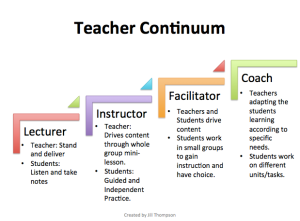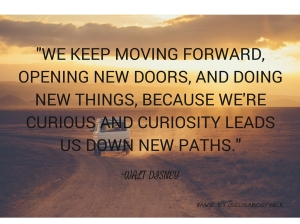New Era: Teacher As Coach
When colleagues have entered my room, at first glance they thought I wasn’t there. I recall the bewildered look of one administrator who I worked for as he scanned the room thinking I had left it unattended. Typically one of the student leaders in my room will notice and point them in my direction. You see, as a coach I’m beside my learners as I question, reflect and provide feedback.
Conflicting Titles
While I view myself as a learning coach, my current title reads as “teacher.” I’m hard pressed to identify a “teacher” who fits the description below from the Merriam-Webster online Dictionary.
teacher noun: a person whose job is to teach students about certain subjects.
First Known Use: 14th century
Definition of TEACHER for Kids: a person who passes on information or skill
I interpret this definition of teacher as someone who can stand, speak, demonstrate, and ta-dah! Learners will absorb the knowledge. We all know this isn’t the case. It seems crazy that we are using a term from the 14th century simply because it’s the way it has always been. No longer are we a person who passes on information or a skill and we do not behold all knowledge. In the 21st century our focus has shifted to facilitating student learning while coaching students in diverse ways and to support them to reach their full potential by empowering students to take ownership in their education. Learners need to be equipped with the ability to collaborate, think critically, create and communicate.
Shifting
The art of teaching has transformed over the years and while we recognize it, we tend to hold onto familiar and traditional terms that are no longer fitting. In our schools, it’s critical that we facilitate learning as coaches who utilize formative assessment while providing a loop of feedback, assist learners in setting personal and team learning targets, contribute and are accessible to assist in reflection, and encourage learners to move beyond their comfort level of learning to support them to be future ready.
As we examine the graphic of the Teacher Continuum we can see the progression. Consider the term “coach.” When I hear the term coach I envision someone beside me who is encouraging and supporting my effort, analyzing and reflecting along with me on where I can improve, as well as noting what I’m doing well. This reminds me of Notre Dame’s head football coach, Brian Kelly’s, coaching philosophy. As players make mistakes, he pulls them to the side to provide direct feedback without emotion so that the players remain confident in their abilities with a growth mindset to step back on the field to accomplish their goals. This is contrary to how many football coaches approach their players’ mistakes.
We need to be cognizant as educators of our own demeanor so that students can maintain confidence and develop a growth mindset. The feedback loop is critical as it allows learners to grow uniquely based on their specific needs and continuously refine. I’ve found value in making sure that my facilitation of learning is diverse to meet the needs of all learners through thoughtfully planned mini-lessons and small groups, since there’s no approach that is one size fits all. We need to maintain the role of coach at all times while remaining mindful of student learning needs and focus on visible student engagement in their learning.

Student Leadership
In my classroom we take a proactive approach to learning in order for me to successfully facilitate as a coach. From day one, learners are identified as leaders in our learning space. I explain that while they may not feel like a leader yet, they soon will. As coaches we need to set the stage for learners to grow into leadership roles. This provides more of an opportunity for “teachers” to transition to being a coach and lessen the amount of teacher driven instruction.
As the first month progresses learners begin to grasp that my role is coach and therefore we have a lot of shared responsibility. I’m able to be a coach simply because students are empowered as leaders in our learning space. When their partner is off task, they check in with them and redirect. If students have questions, they ask one another and are allowed to move around the room to seek others’ ideas. This is modeled, practiced and feedback is provided in order for fluid interactions and transitions. As the year progresses, students begin to take further ownership to maneuver the physical learning space to meet their needs and they take initiative to ensure that their time is used productively.
Community and Structures
Shifting to coach places leadership responsibility on learners. By providing structures within a supportive community, students become trusting to take risks and confident to lead their peers. Our community is fostered during the first week and then enhanced all year through community building structures. We also use Habits of Mind and The 7 Habits of Happy Kids structures from The Leader in Me to cultivate a community where learning can be synergistic. When learners are empowered and grasp how to function as a community it allows ample time for me to connect as a coach to be beside the learner.Learners benefit from both teacher as coach and student leadership. They go hand-in-hand to cultivate an authentic community environment where learners take ownership over their choices, learning, and develop the ability to lead their peers with empathy. I’m confident that in our learning space students are not only cognitively engaged in exploring, researching, and learning, but also developing skills to be independent, critical thinkers. I could not coach as effectively if our learning environment was developed based on teacher ownership.
Coaching Opportunities
Inquiry based instruction, guided reading, math talk, PBL, and open exploration within makerspace provides ultimate opportunities for coaching learners. As we coach learners individually or in teams, they engage in collaborative conversations around content with one another by explaining their reasoning. They practice listening to the perspectives of others and develop a deeper understanding around the content while simultaneously sharpening communication skills. We need to model and then coach collaborative conversation intention
ally in order for learners to engage in authentic and purposeful conversation. Meanwhile as students engage in being coached, they begin to transfer the coaching skills and utilize it with one another. For me, this is when I feel enlightened. After all, we want to support students to be proactive in their learning and develop self-efficiency.
Pioneering
Each of us has the ability to shift and make improvements in the way we currently “teach” or coach. As pioneers in education we need to anticipate change because nothing stays the same. As the future continues to evolve we must think on our feet, be flexible, and prepared to adjust. By stepping into the role as coach our understanding of the learner grows to new heights. We can then further retool instructional strategy and refine student learning targets to meet the needs of each individual. Automatically my mind shifts to seeking, “then what?” There will always be a next step as we pioneer forward. I’ve shifted from teacher, to facilitator, to coach. As societal needs change and new careers evolve within our economy, it’s exciting to ponder the thoughts of my next role in the classroom to support students in their journey of college and career readiness.

I dedicate this post to my closest thought partner, Michael Bostwick (@m_bostwick), who takes the time to provide insight.

